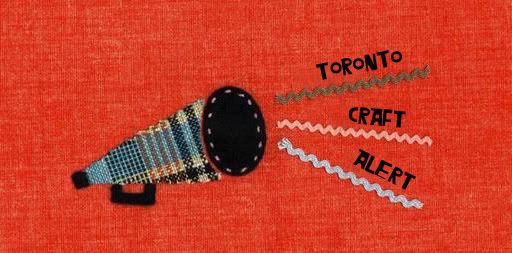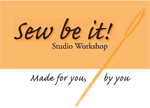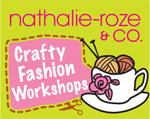QUESTIONS FOR CRAFTERS: Todd Falkowsky of Motherbrand
You’d have to have been living under a rock to not notice that Canadian design is uber-hot, exciting and everywhere these days. We now occupy a place on the design world stage and let’s face it – it’s about bloody time. Themes of nature, kitsch and dashes of humour have begun to define this current wave. And that wave, according to some, was started by designers Todd Falkowsky and Michael Erdmann of Motherbrand with their Cabin Project and stoked by their other babies; The Canadian Design Resource and The Souvenir Shop.
Allow me to explain - Cabin Project was an international sensation that traveled to many design shows asking our local designers to reinterpret the Canadian wilderness mythology. Log bowls, a groovy chair covered in a Bay blanket and a mason jar cream and sugar set are just a few of the pieces to emerge from Motherbrand’s concept. The Canadian Design Resource is a database of our material culture and loads of fun to peruse. Entries are informative and sometimes hilarious and loaded with nostalgia – check it out. And finally, The Souvenir Shop, their latest giant, is an online store with a real live physical space in

L: Urban Archeology Bricks by Robin Tieu, R: RV Vase by Paige Russell
Both available through The Souvenir Shop
I had a chance to speak with Falkowsky recently at his office at OCAD where he is currently a professor in the Faculty of Design. He of course had loads to say about this exciting time in Canadian design and his company’s place within it.
According to Falkowsky, Motherbrand and their leadership position evolved from humble beginnings. Erdmann and he met at design school in
Those voices seemed to speak directly to each other and to a theme. Granted that theme surfaced through a submissions call for the Cabin Project, but according to Falkowsky, the theme of nature was bound to surface as we can’t turn our backs on the reality of the country we live in. Returning to

L: Louis Riel Figurine by Erin McCutcheon, R: Antler Ring by Anneke Van Bommel
Both available through The Souvenir Shop
But does it resonate with everyone? Many of us are new to this country and have no interaction with the wilderness. We are living in cities and suburbs coming from countries majorly south of the tree line. I asked him specifically about how immigration will affect future themes and if this trend of antler-chic can truly resonate with new Canadians. Well, before you start screaming ‘right on sister this is just for the sophisticated hosers’ – Falkowsky was quick to inform me that many of the works in the Souvenir Shop are made by First Generation Canadians.
Through his travels with the Cabin Project he learned that the world viewed
Given the state of our global economy I asked Falkowsky if a national voice is still necessary. “The day Nike made a
And the public is catching up. Where Canadians were once “bashful” about facing the themes and icons Motherbrand celebrates, they are now embracing their beauty, humour and dare I say, meaning. That being said, it’s the international community that buys the most from the Souvenir Shop. Ah, Canadian irony.
But fear not my fellow Canadians – we are slowly beginning to take pride in the incredible works on view throughout the country and we are even starting to acknowledge our design goodies from the past as well. The user-driven database that is the Canadian Design Resource encompasses the entire spectrum of Canadian design product. We’re talking print, ceramics, old stereos, Cougar Boots, all sorts of furniture – basically a material history of

L:Canning Jars of Canada, R:
There are a core group of contributors, but anyone can submit a piece to be posted and anyone can join in on the comments. What they thought was going to be a higher level discourse on design, actually ended up as a storytelling venue for the collectors, creators and lovers of our material past. As Falkowsky says the CDR is “mandate-less” so that’s the direction it went. It became up to the users to “collect pieces that they (thought would) tell a story.” This thread of discussion and the new projects they are inspiring is the biggest pay-off to Falkowsky. “My proudest moment is that it has become a catalyst.” With 3,000,000 hits a month, a twice-crashed server and users throughout the globe, he and his collaborators are not just a catalyst but also a seismic shift.
Being from the TCA I had to ask – all this local talk sounded super-familiar, some might say a wee bit crafty. We talk design, we talk craft, but are they really that separate? Take note – Falkowsky doesn’t think so. He told me that the design community “owes a lot to the craft side.” Upon his return to
For Motherbrand it truly is about showing the world where the hell Canadian design is and getting money back to the guys who are making the fantastic works. Are they responsible for the wave? Who cares. I just know their efforts have fueled the fire that is this new Canadian design movement. Let’s just hope that it doesn’t take a number of years of therapy to appreciate this mother. With all their inspiration and successes, somehow I don’t think we have to worry.
Michelle Rothstein is a























2 Comments:
Wow. Who knew, Michelle? Thanks - can't wait to start shopping...
Thanks for thinking of us and our projects.
I am excited about the Canadian creative community and look forward to the opportunities that we collective create and share.
Success!
Todd Falkowsky
Post a Comment
<< Home